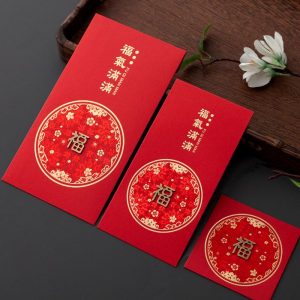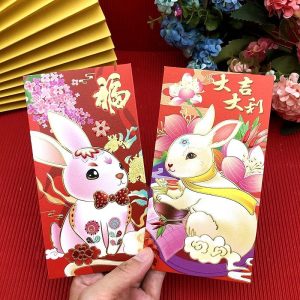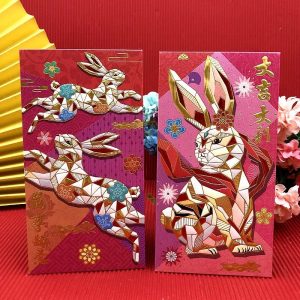Red packets play a significant role in the traditional cultures of China and many other Asian countries. With the advancement of technology and increasing demand for personalization, red packet have emerged as an innovative tool bridging tradition and modernity. This article will explore the design, usage, and impact of red packet templates on modern cultural practices.

The Importance of Red Packet Templates
Red packet allow individuals or businesses to customize designs based on specific festivals, celebrations, or marketing campaigns. These templates offer a way for red packets to be more than just a tool for transferring wealth; they become a platform for showcasing individuality and creativity. With a variety of patterns, colors, and text options, red packet templates can accurately reflect the giver’s emotions and blessings.
Design Innovation
The design of red packet involves a range of elements, from traditional symbols to modern graphic designs. Designers might incorporate auspicious Chinese motifs like the character for fortune, fish, and lotus flowers—symbols rich with cultural significance. Additionally, with the rise of personalization trends, more templates are incorporating modern and pop culture elements, such as cartoon characters, trendy slogans, and creative patterns, catering to diverse market demands and aligning with the aesthetics of the younger generation.
Application Scenarios
Red packet are widely used in various settings, such as during Lunar New Year, weddings, birthdays, and other significant festivals and personal celebrations. In the business realm, companies can use customized red packet to enhance brand recognition by printing their logos, slogans, or specific advertising messages on the packets, effectively combining cultural tradition with brand marketing.
Digitalization and Sustainability
Digital red packet offer an eco-friendly and sustainable option. With the popularity of digital payments, electronic red packets are becoming increasingly favored, allowing people to send electronically with personalized template designs through smartphone apps. This not only reduces the use of paper red packets but also aligns with contemporary societal goals for environmental protection and sustainability.
Conclusion
Red packet , as a blend of traditional culture and modern design, not only enhance the aesthetic and personalized appeal of red packets but also reflect the adaptability and innovation of cultural products in a globalized era. As design tools and technologies continue to advance, the applications of red packet will expand further, providing people with more ways to express their blessings and joy.

The Significance and Tradition of Red Packets
Introduction
Red packets, known as “hongbao” in Chinese, are a significant tradition in Chinese culture, symbolizing good fortune, prosperity, and blessings. These red envelopes, typically filled with money, are given during special occasions such as Lunar New Year, weddings, and other celebrations. The red color of the packets is considered to bring good luck and ward off evil spirits. This article delves into the history, cultural significance, and modern practices surrounding red packets.
Historical Background
The tradition of giving red packets dates back centuries, rooted in ancient Chinese customs. Historically, red packets were given to ward off evil spirits, particularly during the Lunar New Year. Legend has it that a demon named “Sui” would terrorize children on New Year’s Eve. Parents would give their children coins wrapped in red paper to protect them from the demon. Over time, this practice evolved into the modern tradition of giving red packets.
Cultural Significance
- Symbolism of Red:
- Red is a powerful color in Chinese culture, symbolizing luck, happiness, and vitality. The red packet itself is a token of good wishes and positive energy.
- Blessings and Good Fortune:
- Red packets are not just about the money inside; they represent the giver’s blessings and hopes for the recipient’s success, health, and happiness. The act of giving and receiving red packets fosters a sense of community and connection.
- Customs and Etiquette:
- There are specific customs and etiquette associated with red packets. For instance, the amount of money given should always be an even number, as odd numbers are associated with funerals. Additionally, the packets are often given with both hands, and it is polite to receive them with both hands as well.
Occasions for Giving Red Packets
- Lunar New Year:
- During the Lunar New Year, red packets are given to children, unmarried adults, and employees. The packets are meant to bring good luck and prosperity for the coming year.
- Weddings:
- At weddings, red packets are given to the newlyweds as a symbol of good fortune and to help them start their new life together. Guests often give red packets in place of gifts.
- Other Celebrations:
- Red packets are also given during birthdays, baby showers, and other celebrations, always symbolizing good wishes and blessings. Red Packet Templates
Modern Practices
In modern times, the tradition of red packets has evolved with technology. Digital red packets, sent via mobile apps, have become popular, especially among younger generations. Despite this shift, the traditional practice of giving physical red packets remains strong, particularly during major celebrations.Red Packet Templates
- Digital Red Packets:
- Mobile payment platforms like WeChat and Alipay offer digital red packets, allowing users to send money and blessings electronically. This modern twist on an ancient tradition has made it easier to share good fortune, especially with distant relatives and friends.
- Customization and Personalization:
- Today, red packets come in various designs and themes, reflecting personal tastes and the nature of the celebration. Customized red packets with names, messages, or unique designs add a personal touch to the tradition.
How to Make Your Own Red Packets
Creating your own red packets can add a personal and creative touch to this cherished tradition. Here’s a simple guide to making DIY red packets:
- Materials:
- Red paper or cardstock
- Gold and silver pens or markers
- Glue or double-sided tape
- Scissors
- Decorative stickers, stamps, or washi tape
- Instructions:
- Cut the red paper into a rectangle (approximately 6×8 inches).
- Fold the paper into an envelope shape: fold one-third of the paper towards the center, then fold the other side to overlap slightly and secure with glue or tape.
- Fold up the bottom edge and secure it to create the pocket.
- Decorate the packet with gold and silver pens, adding traditional symbols or personal messages.
Conclusion
Red packets are a beautiful blend of tradition and symbolism, deeply embedded in Chinese culture. Whether given during the Lunar New Year, at weddings, or other celebrations, they represent more than just money—they are tokens of love, respect, and well-wishes. Embracing both traditional and modern practices, the giving of red packets continues to be a meaningful and cherished custom, fostering connections and bringing joy to both the giver and the recipient.

Red Packet Design: Creating Elegant and Festive Envelopes
Introduction
Red packets, also known as “hongbao,” are an integral part of Chinese cultural celebrations, symbolizing luck and prosperity. Designing your own red packets can make the tradition even more special. Whether you want to create traditional designs or add a modern twist, this guide will help you create beautiful and meaningful red packets.
Elements of Traditional Red Packet Design
- Color:
- Red: The primary color symbolizes luck, joy, and prosperity.
- Gold: Often used for embellishments and text, gold represents wealth and good fortune.
- Symbols:
- Double Happiness (囍): Commonly used for weddings, this symbol represents joy and marriage.
- Dragons and Phoenixes: Symbolizing power, strength, and harmony, these motifs are popular in traditional designs.
- Zodiac Animals: Each Lunar New Year is associated with a specific zodiac animal, which can be incorporated into the design.
- Patterns:
- Floral Designs: Peonies and lotuses are frequently used to symbolize wealth and purity.
- Geometric Patterns: Intricate patterns can add an elegant touch to the design.
- Text:
- Common phrases include “Gong Xi Fa Cai” (恭喜发财) meaning “Wishing you prosperity,” and “Xin Nian Kuai Le” (新年快乐) meaning “Happy New Year.”
Modern Red Packet Design Ideas
- Minimalist Design:
- Use clean lines and simple shapes with subtle gold or silver accents.
- Incorporate modern fonts and minimal text.
- Personalized Designs:
- Include names, personalized messages, or photos to make the red packets unique to the recipient.
- Thematic Designs:
- Create themes based on specific interests or occasions, such as floral themes for spring, or cute cartoon characters for children.
- Eco-Friendly Materials:
- Use recycled paper or sustainable materials to create eco-friendly red packets.
DIY Red Packet Design Guide
- Materials Needed:
- Red paper or cardstock
- Gold and silver pens or markers
- Glue or double-sided tape
- Scissors
- Ruler and pencil
- Decorative stickers, stamps, or washi tape
- Optional: Embellishments like rhinestones, fabric flowers, or beads
- Basic Design Steps:
- Cutting the Paper: Start with a piece of red paper or cardstock, typically 6 inches by 8 inches.
- Folding the Packet: Fold one-third of the paper from the left side towards the center, then fold the right side over to meet the left fold, overlapping slightly. Secure with glue or tape.
- Creating the Flap: Fold up the bottom inch of the paper and secure it to create the pocket. Fold down the top inch to create the flap.
- Decorating the Packet:
- Use gold and silver pens to draw traditional symbols and write auspicious phrases.
- Add stickers, stamps, or washi tape to enhance the design.
- For a luxurious touch, attach small embellishments like rhinestones or fabric flowers.
Step-by-Step Example: Traditional Red Packet
- Prepare the Paper:
- Cut a 6×8 inch rectangle from red cardstock.
- Fold and Secure:
- Fold the left third of the paper towards the center.
- Fold the right third to overlap the left fold and secure with double-sided tape.
- Create the Bottom Flap:
- Fold up the bottom inch of the paper and secure it with tape to form the pocket.
- Decorate:
- Use gold pens to draw a dragon and phoenix on the front.
- Write “恭喜发财” (Gong Xi Fa Cai) in gold along the top.
- Finishing Touches:
- Add a strip of gold washi tape along the bottom edge.
- Attach a small red tassel to the flap for an extra festive touch.
Conclusion
Designing your own red packets allows you to blend tradition with personal creativity. Whether you opt for classic symbols and colors or experiment with modern styles, your handmade red packets will undoubtedly bring joy and prosperity to their recipients. Embrace the opportunity to make each red packet a unique and meaningful part of your celebrations.